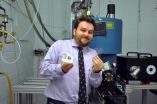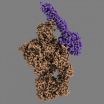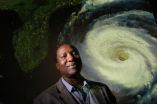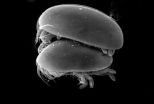(Press-News.org) September 10, 2012-- Issued by the UNIVERSITY OF TORONTO
Under strict embargo by Nature Communications until Tuesday, September 11, 11 a.m. EST
An international team led by University of Toronto physicists has developed a simple new technique using Scotch poster tape that has enabled them to induce high-temperature superconductivity in a semiconductor for the first time. The method paves the way for novel new devices that could be used in quantum computing and to improve energy efficiency.
"Who would have thought simply sticking things together can generate entirely new effects?" said team leader and U of T physicist Ken Burch.
High-temperature superconductors are materials that conduct electricity without heating up and losing energy at liquid nitrogen temperatures. They are currently in use for transmitting electricity with low loss and as the building blocks of the next generation of devices (quantum computers).
However, only certain compounds of iron, copper and oxygen – or cuprates – reveal high-temperature superconducting properties. Cuprates were believed to be impossible to incorporate with semi-conductors, and so their real-world use has been severely limited as has the exploration of new effects they may generate. For example, observing the phenomenon of the proximity effect – wherein the superconductivity in one material generates superconductivity in an otherwise normal semi-conductor – has been difficult because the fundamental quantum mechanics require the materials to be in nearly perfect contact.
That's where the poster tape comes in. "Typically, junctions between semi-conductors and superconductors were made by complex material growth procedures and fabricating devices with features smaller than a human hair," explains Burch. "However the cuprates have a completely different structure and complex chemical make-up that simply can't be incorporated with a normal semiconductor."
So instead, the team used Scotch poster tape and glass slides to place high-temperature superconductors in proximity with a special type of semi-conductor known as a topological insulator. Topological insulators have captured world-wide attention from scientists because they behave like semi-conductors in the bulk, but are very metallic at the surface. The result was induced superconductivity in these novel semi-conductors: a physics first.
INFORMATION:
The U of T team members include Kenneth S. Burch, Alex Hayat, Parisa Zareapour, Shu Yang F. Zhao, Michael Kreshchuk, Achint Jain. All are members of the Department of Physics and Institute for Optical Sciences and Alex Hayat who holds an additional appointment with U of T's Centre for Quantum Information and Quantum Control. Other scientists collaborating on the project are: Sang-Wook Cheong, Daniel C. Kwok and Nara Lee of Rutgers University, G.D. Gu, Ahijun Xu and Zhijun Xu of Brookhaven National Laboratory and Robert Cava of Princeton.
The work was supported by the Natural Sciences and Engineering Research Council of Canada, the Canadian Foundation for Innovation, the Ontario Ministry for Innovation and the National Science Foundation.
MEDIA CONTACTS:
Kenneth Stephen Burch
Department of Physics
Institute for Optical Sciences
University of Toronto
kburch@physics.utoronto.ca
647-403-4176
416-978-5264
Kim Luke
Communications
Faculty of Arts & Science
University of Toronto
kim.luke@utoronto.ca
416-978-4352
U of Toronto-led team induces high-temperature superconductivity in a semiconductor with Scotch tape
Paves way for quantum computing and improvements in energy efficiency
2012-09-11
ELSE PRESS RELEASES FROM THIS DATE:
New discovery related to gum disease
2012-09-11
A University of Louisville scientist has found a way to prevent inflammation and bone loss surrounding the teeth by blocking a natural signaling pathway of the enzyme GSK3b, which plays an important role in directing the immune response.
The discovery of UofL School of Dentistry researcher David Scott, PhD, and his team recently published on-line first in the journal Molecular Medicine. The finding not only has implications in preventing periodontal disease, a chronic inflammatory disease that causes tooth loss, but also may have relevance to other chronic inflammatory ...
Breast cancer risks acquired in pregnancy may pass to next 3 generations
2012-09-11
Chemicals or foods that raise estrogen levels during pregnancy may increase cancer risk in daughters, granddaughters, and even great-granddaughters, according to scientists from Virginia Tech and Georgetown University.
Pregnant rats on a diet supplemented with synthetic estrogen or with fat, which increases estrogen levels, produce ensuing generations of daughters that appear to be healthy, but harbor a greater than normal risk for mammary cancer, the researchers report in today's Nature Communications.
Although the findings have not yet been validated in humans, the ...
Unnecessary oil disasters
2012-09-11
The BP oil disaster in the Gulf of Mexico 2010 could have been avoided if the experiences of earlier disasters had been put to use, researcher Charles Woolfson, Linköping university, claims. The United States government is now accusing BP of gross negligence and deliberate misconduct, and taking the company to court.
On April 20, 2010, the Deepwater Horizon oil rig exploded in the ocean south of the southern coast of the US. The explosion led to the deaths of eleven people and an unfathomable environmental catastrophe.
Charles Woolfson, former professor of Labour Sociology ...
Serious games could be integrated into surgical training subject to validation
2012-09-11
Serious gaming can be used to enhance surgical skills, but games developed or used to train medical professionals need to be validated before they are integrated into teaching methods, according to a paper in the October issue of the surgical journal BJS.
Researchers from The Netherlands reviewed 25 research studies covering 30 serious games published between 1995 and 2012.
"Many medical professionals may still have a rather out-dated view of the average gamer as being someone who is too young to vote, afraid of daylight and busy killing mystical dwarves in their parent's ...
Chain reaction in the human immune system trapped in crystals
2012-09-11
VIDEO:
The animation shows how the MASP-2 (blue) attaches itself to the complement protein C4 (orange), and the structural rearrangements that occur in the C4 due to this. Note that although...
Click here for more information.
The complement system is part of the innate immune system and is composed of about 40 different proteins that work together to defend the body against disease-causing microorganisms. The complement system perceives danger signals in the body by recognising ...
More traffic deaths in wake of 9/11
2012-09-11
This press release is available in German.
In the wake of the terrorist attacks of September 11, 2001, many Americans started driving more due to a fear of flying – and lost their lives in traffic accidents. But why did this happen more frequently in some states than in others? And why didn't Spanish driving habits change in the same way following the 2004 train bombings in Madrid? Wolfgang Gaissmaier and Gerd Gigerenzer from the Harding Center for Risk Literacy at the Max Planck Institute for Human Development in Berlin present new findings on this topic in the ...
Lights off? International experts call attention to dangers of exposure to light at night
2012-09-11
"The most important thing for us is to raise awareness of the dangers of artificial light at night and we have already come a long way now that the American Medical Association (AMA) recently announced its new policy recognizing adverse health effects of exposure to light at night and encouraging further research into the matter," said Prof. Abraham Haim, a leading authority on light pollution, who coordinated the 21st International Congress of Zoology (ICZ) that was held last week at the University of Haifa, Israel.
The panel of world experts discussed "Light Pollution ...
Researchers devise more accurate method for predicting hurricane activity
2012-09-11
Researchers from North Carolina State University have developed a new method for forecasting seasonal hurricane activity that is 15 percent more accurate than previous techniques.
"This approach should give policymakers more reliable information than current state-of-the-art methods," says Dr. Nagiza Samatova, an associate professor of computer science at NC State and co-author of a paper describing the work. "This will hopefully give them more confidence in planning for the hurricane season."
Conventional models used to predict seasonal hurricane activity rely on classical ...
A minute crustacean invades the red swamp crayfish
2012-09-11
The small ostracod Ankylocythere sinuosa measures no more than half a millimetre in length and lives on other crayfish. And, Spanish scientists have discovered it for the first time in Europe. The finding suggests that it arrived along with the invader crayfish Procambarus clarkii some 30 years ago but it is still unknown whether it can invade other crustacean species or whether it benefits or damages the expansion of the already established red swamp crayfish.
The red swamp crayfish (Procambarus clarkii) originates from the USA and Mexico and has been present in the Iberian ...
Dartmouth research imparts momentum to mobile health
2012-09-11
Electronic Jewelry for Health
Bracelets and amulets are in the works at Dartmouth's Institute for Security, Technology, and Society (ISTS). Rather than items of mere adornment, the scientists and engineers are constructing personal mobile health (mHealth) devices—highly functional jewelry, as it were.
mHealth is a rapidly growing field where technology helps you or your physician monitor your health through mobile devices. This approach can offer more accurate and timely diagnoses as well as lower health costs. However, smartphones are often used to transmit collected ...
LAST 30 PRESS RELEASES:
Injectable breast ‘implant’ offers alternative to traditional surgeries
Neuroscientists devise formulas to measure multilingualism
New prostate cancer trial seeks to reduce toxicity without sacrificing efficacy
Geometry shapes life
A CRISPR screen reveals many previously unrecognized genes required for brain development and a new neurodevelopmental disorder
Hot flush treatment has anti-breast cancer activity, study finds
Securing AI systems against growing cybersecurity threats
Longest observation of an active solar region
Why nail-biting, procrastination and other self-sabotaging behaviors are rooted in survival instincts
Regional variations in mechanical properties of porcine leptomeninges
Artificial empathy in therapy and healthcare: advancements in interpersonal interaction technologies
Why some brains switch gears more efficiently than others
UVA’s Jundong Li wins ICDM’S 2025 Tao Li Award for data mining, machine learning
UVA’s low-power, high-performance computer power player Mircea Stan earns National Academy of Inventors fellowship
Not playing by the rules: USU researcher explores filamentous algae dynamics in rivers
Do our body clocks influence our risk of dementia?
Anthropologists offer new evidence of bipedalism in long-debated fossil discovery
Safer receipt paper from wood
Dosage-sensitive genes suggest no whole-genome duplications in ancestral angiosperm
First ancient human herpesvirus genomes document their deep history with humans
Why Some Bacteria Survive Antibiotics and How to Stop Them - New study reveals that bacteria can survive antibiotic treatment through two fundamentally different “shutdown modes”
UCLA study links scar healing to dangerous placenta condition
CHANGE-seq-BE finds off-target changes in the genome from base editors
The Journal of Nuclear Medicine Ahead-of-Print Tip Sheet: January 2, 2026
Delayed or absent first dose of measles, mumps, and rubella vaccination
Trends in US preterm birth rates by household income and race and ethnicity
Study identifies potential biomarker linked to progression and brain inflammation in multiple sclerosis
Many mothers in Norway do not show up for postnatal check-ups
Researchers want to find out why quick clay is so unstable
Superradiant spins show teamwork at the quantum scale
[Press-News.org] U of Toronto-led team induces high-temperature superconductivity in a semiconductor with Scotch tapePaves way for quantum computing and improvements in energy efficiency




